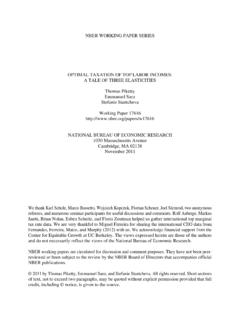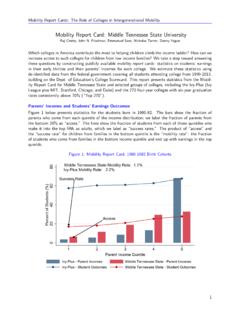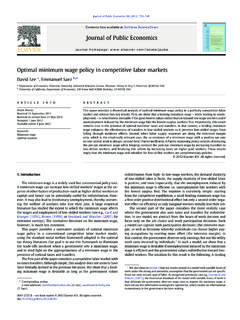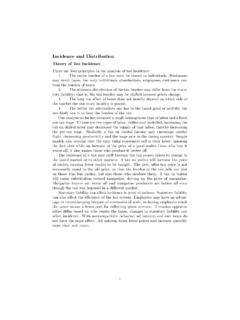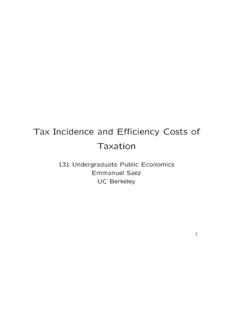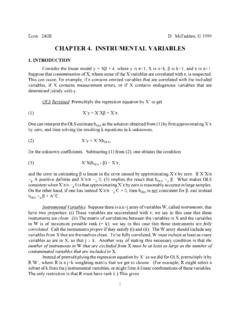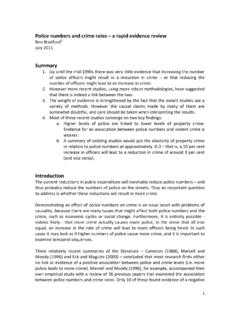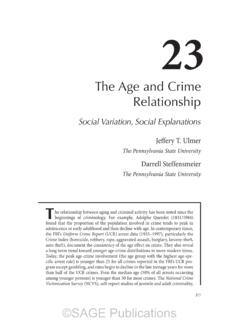Transcription of Does Movie Violence Increase Violent Crime?
1 Does Movie Violence Increase Violent crime ? . Gordon Dahl Stefano DellaVigna UC San Diego and NBER UC Berkeley and NBER. This version: December 20, 2007. Abstract Laboratory experiments in psychology find that media Violence increases aggression in the short run. We analyze whether media Violence a ects Violent crime in the field. We exploit variation in the Violence of blockbuster movies from 1995 to 2004, and study the e ect on same-day assaults. We find that Violent crime decreases on days with larger theater audiences for Violent movies . The e ect is partly due to voluntary incapacitation: between 6PM and 12AM, a one million Increase in the audience for Violent movies reduces Violent crime by to percent. After exposure to the Movie , between 12AM and 6AM, Violent crime is reduced by an even larger percent.
2 This finding is explained by the self-selection of Violent individuals into Violent Movie attendance, leading to a substitution away from more volatile activities. In particular, Movie attendance appears to reduce alcohol consumption. Like the laboratory experiments, we find indirect evidence that Movie Violence increases Violent crime ; however, this e ect is dominated by the reduction in crime induced by a substitution away from more dangerous activities. Overall, our estimates suggest that in the short-run Violent movies deter almost 1,000 assaults on an average weekend. While our design does not allow us to estimate long-run e ects, we find no evidence of medium-run e ects up to three weeks after initial exposure.. Eli Berman, Sofia Berto Villas-Boas, Saurabh Bhargava, David Card, Christopher Carpenter, Ing-Haw Cheng, Julie Cullen, Liran Einav, Matthew Gentzkow, Jay Hamilton, Ethan Kaplan, Lawrence F.
3 Katz, Lars Lefgren, Ulrike Malmendier, Julie Mortimer, Ted O'Donoghue, Anne Piehl, Mikael Priks, Uri Simonsohn, and audiences at London School of Economics, Ohio State, Queens University, Rutgers New Brunswick, UC Berkeley, UC San Diego, University of Tennessee Knoxville, University of Western Ontario, University of Zurich, Wharton, the Munich 2006 Conference on Economics and Psychology, the NBER 2006 Summer Institute (Labor Studies), the 2006 SITE in Psychology and Economics, the IZA Conference on Personnel and Behavioral Economics, the IZA/SOLE Transatlantic Meeting of Labor Economists, and at the Trento 2006 Summer School in Behavioral Economics provided useful comments. We would like to thank and for generously providing their data. Scott Baker and Thomas Barrios provided excellent research assistance.
4 1 Introduction Does media Violence trigger Violent crime ? This question is important for both policy and scientific research. In 2000, the Federal Trade Commission issued a report at the request of the President and of Congress, surveying the scientific evidence and warning of negative consequences. In the same year, the American Medical Association, together with five other public-health organizations, issued a joint statement on the risks of exposure to media Violence (Joint Statement, 2000). The evidence cited in these reports, surveyed by Anderson and Buschman (2001) and Anderson et al. (2003), however, does not establish a causal link between media Violence and Violent crime . The experimental literature exposes subjects in the laboratory (typically children or college students) to short, Violent video clips.
5 These experiments find a sharp Increase in aggressive behavior immediately after the media exposure, compared to a control group exposed to non- Violent clips. This literature provides causal evidence on the short-run impact of media Violence on aggressiveness, but not whether this translates into higher levels of Violent crime in the field. A second literature ( , Johnson et al., 2002) shows that survey respondents who watch more Violent media are substantially more likely to be involved in self- reported Violence and crime . This second type of evidence, while indeed linking media Violence and crime , is plagued by problems of endogeneity and reverse causation. In this paper, we provide causal evidence on the short-run effect of media Violence on Violent crime . We exploit the natural experiment induced by time-series variation in the Violence of movies shown in the theater.
6 As in the psychology experiments, we estimate the short-run effect of exposure to Violence , but unlike in the experiments, the outcome variable is Violent crime rather than aggressiveness. Importantly, the laboratory and field setups also differ due to self-selection and to the context of Violent media exposure. Using a Violence rating system from and daily revenue data, we generate a daily measure of national-level box office audience for strongly Violent ( , Hannibal ), mildly Violent ( , Spider-Man ), and non- Violent movies ( , Runaway Bride ). Since blockbuster movies differ significantly in Violence rating, and Movie sales are concentrated in the initial weekends after release, there is substantial variation in exposure to Movie Violence over time. The audience for strongly Violent and mildly Violent movies , respectively, is as high as 12 million and 25 million people on some weekends, and is close to zero on others (see Figures 1a-1b).
7 We use crime data from the National Incident Based Reporting System (NIBRS) and measure Violent crime on a given day as the sum of reported assaults (simple or aggravated) and intimidation. We find no evidence that exposure to media Violence increases Violent behavior in the short- run. After controlling flexibly for seasonality, we find that, on days with a high audience for Violent movies , Violent crime is lower. To rule out unobserved factors that contemporaneously 1. Increase Movie attendance and decrease Violence , such as rainy weather, we use two strategies. First, we add controls for weather and days with high TV viewership. Second, we instrument for Movie audience using the predicted Movie audience based on the following weekend's au- dience. This instrumental variable strategy exploits the predictability of the weekly decrease in attendance.
8 Adding in controls and instrumenting, the correlation between Movie Violence and Violent crime becomes more negative and remains statistically significant. The estimated effect of exposure to Violent movies is small in the morning or afternoon hours (6AM-6PM), when Movie attendance is minimal. In the evening hours (6PM-12AM), instead, we detect a significant negative effect on crime . For each million people watching a strongly or mildly Violent Movie , respectively, Violent crimes decrease by and percent. The effect is smaller and statistically insignificant for non- Violent movies . In the nighttime hours following the Movie showing (12AM-6AM), the delayed effect of exposure to Movie Violence is even more negative. For each million people watching a strongly or mildly Violent Movie , respectively, Violent crime decreases by and percent.
9 Non- Violent movies have no statistically significant impact. Unlike in the psychology experiments, therefore, media Violence appears to decrease Violent behavior in the immediate aftermath of exposure, with large aggregate effects. The total net effect of Violent movies is to decrease assaults by roughly 1,000 occurrences per weekend, for an annual total of about 52,000 weekend assaults prevented. We also examine the delayed impact of exposure to Movie Violence on Violent crime . While our research design (like the laboratory designs) cannot test for a long-run impact, we can examine the medium-run impact in the days and weeks following exposure. We find no impact on Violent crime on Monday and Tuesday following weekend Movie exposure. We also find no impact one, two, and three weeks after initial exposure, controlling for current exposure.
10 This implies that the same-day decrease in crime is unlikely to be due to intertemporal substitution of crime from the following days. To test the robustness of our results, we disaggregate the effects by individual Violence levels ranging from 0 to 10, and by one-hour time blocks. We explore other specifications (including Poisson regression), alternative instrument sets, and an alternative measure of Movie Violence . The results are all consistent with the baseline analysis. Additionally, we generate a placebo data set to test for uncontrolled seasonal factors in Movie releases, and find no effect with the placebo treatment. A final set of results exploits the variation in Movie Violence from rentals of DVDs and VHSs. These estimates are broadly consistent with our main estimates using the box office data, although the standard errors are larger.

